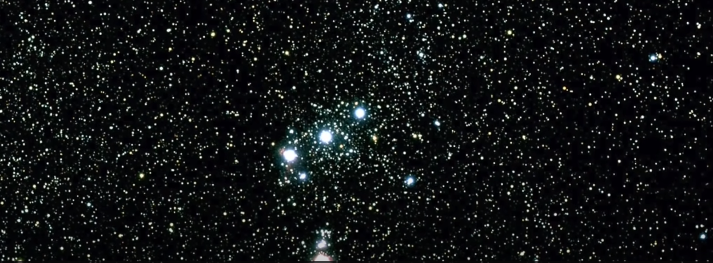In Astronomy, sometimes there are some images which become memorable. This type of one image was taken by humble space telescope in 1995, of a small part of the eagle nebula which was nicknamed “pillars of creation.” This was a very beautiful image and as you can imagine, this was a very beautiful image and as you can imagine, now the James Webb space telescope has taken a picture of the pillars of creation and this image also is stunning. This eagle nebula is such an area where new stars are forming. But its shape this pillar type, how did this form?
Hubble Image of Pillars Of Creation.
Some among you maybe knowing or remembering that then Hubble space telescope was launched in 1990 initially, it was not a success story.
Because at the beginning its main mirror was out of focus meaning the image was came in the beginning were a little blurred. After that, there was a terrific shuttle mission, which in a sense repaired the mirror of the Hubble space telescope Or it gave a contact lens to it because of which the image received afterwards were sharply focused. From those, there was one image of a small part of this eagle nebula which was later named ‘pillars of creation’.

I remember it. I had started graduate school in Astronomy at that time so there was much excitement regarding these images. The picture you are seeing is of Eagle nebula. It is about 6000 light years away from us, and according to scales for example, the pillar on the left side is four light years. If you want to calculate the distance then the nearest star to our sun ‘Proximal Centauri’ is four light years away from us. You can imagine what you are seeing in this nebula.
The eagle nebula is one such place where new stars are forming, in fact, the new stars which form in our galaxy are formed in this type of gas nebula (containing hydrogen). Our sun was also formed in this type of nebula 4.5 billion years ago.
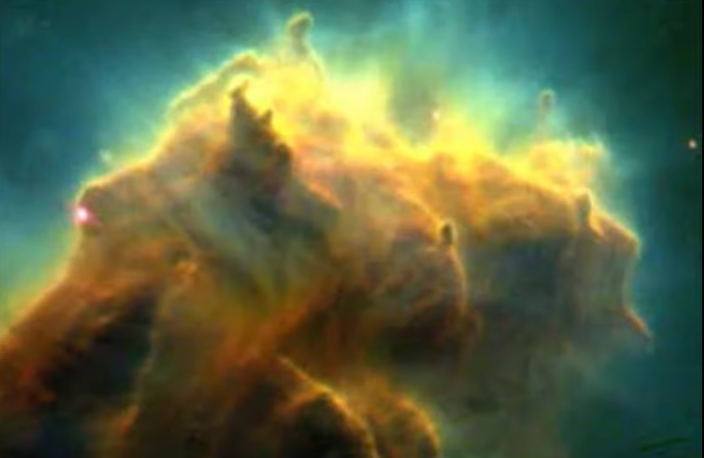
If you see a close-up of Pillars of Creation, you can see small extension here and there is a new star inside these extensions. At that time, this was a revolutionary type of picture because before 1990 (before Hubble space telescope) we used to have a general description in our text books. There is a big nebula, and we used to imagine how new stars would be forming in it. But this image of the eagle nebula provided by the Hubble space telescope, told us the details and gave us a
picture of what type of stars are actually forming in this type of nebula.
And I remember when the initial images of the Hubble space telescope started to come, big event because we used to keep watching that image for several weeks and tried to find out what new information we are getting which we had not seen before.
After many years, then some instruments of open space telescope were upgraded then Hubble space telescope again took pictures of the pillars of creation in 2014
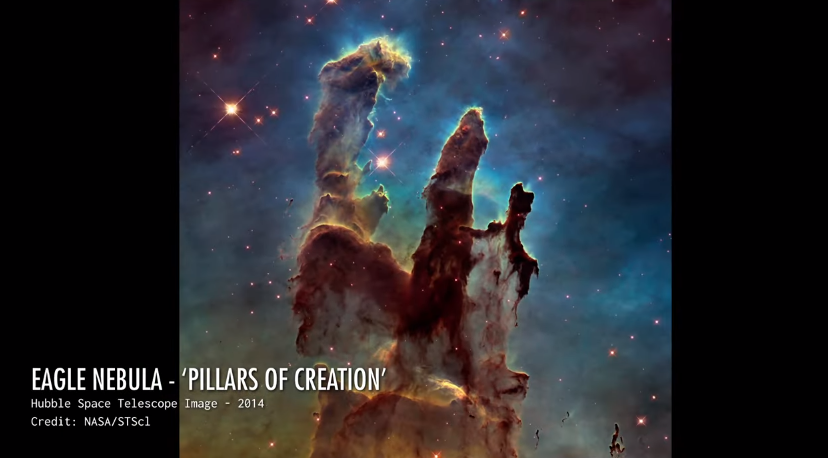
No often our focus is on these pillars because this is a strange picture. But actually this is a part of a bigger nebula. As I said which is the name eagle nebula.
Star Forming Regions
Let’s zoom out a little.
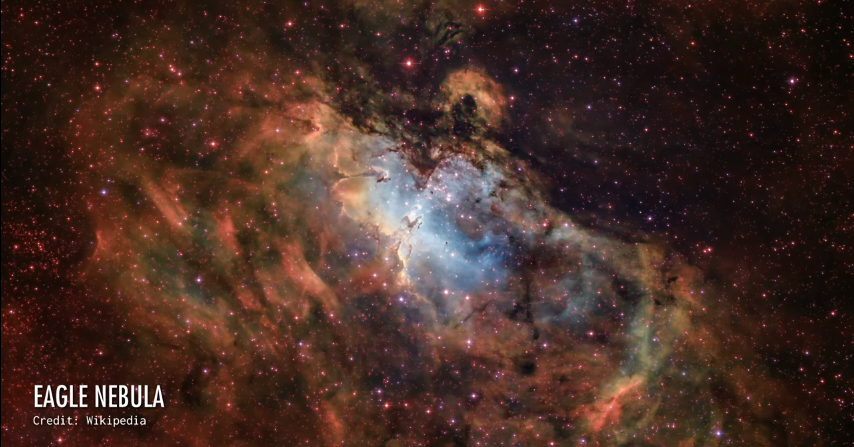
This is the start farming region whose total width is almost 70 ly across. There are about 8000 stars in it and all of them are new stars. No stars is older than 2 or 3 million years.
These pillars of creation became very famous but in fairness have a space telescope has taken photo of many other beautiful stars farming regions. This is a picture from the beginning and became famous because of some orientation. But let me show you some other pictures such as

you can see this is the star farming region name N-90. This is a part of our satellite galaxies Small Magellanic clouds these are also new stars.

The second picture is of a famous area named 30 Doradus in the large Magellanic Cloud (This is also a satellite), you are seeing its picture.
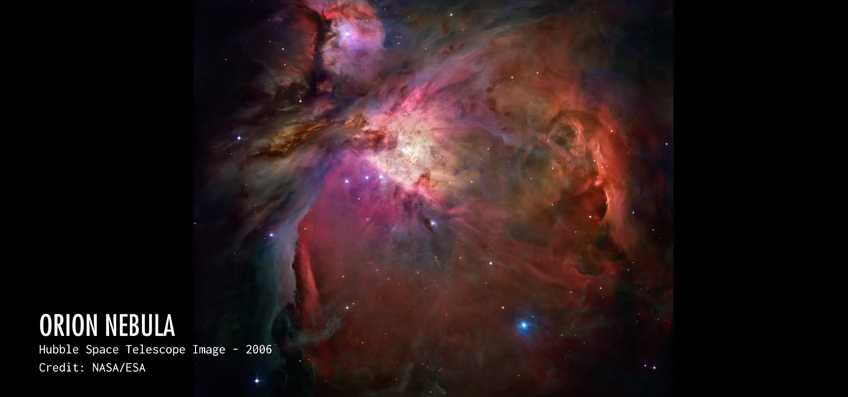
And now you are seeing Orion nebula which is in our own galaxy and it is very near to us, and you can easily see it from earth in winter with a small telescope. This picture was also taken by Hubble space telescope which also saw forming of several new small stars in it. You can check out article in which we dive into this Orion nebula.
Now the orientation (sideways) of these pillars of creation according to us is such that the forming of stars is easily visible to us.
But how did this shape (Pillars of Creation) which I mentioned in the beginning form.
Big Stars Carving the Nebula
Actually, in the star farming region in Eagle nebula many other new stars have already formed. Out of these some stars are much larger than our sun. For example one star HD 168076.

Actually, this is not one star. They are too big stars in a binary system in Pillars of Creation.
This type of big stars are less in numbers but they emit a lot of ultraviolet light. And this ultraviolet or UV light starts to evaporate the gases of the nebula in which they were formed. This process is called photoevaporation by astronomers.
Now because of the photoevaporation of these stars (which form in this very nebula) in a way cavities or cave type or pits start forming, this is the same as water over a long period of time carve out a canyon. In the same way that ultraviolet light of these big stars start carving out these gas nebula.
Astronomers call these small dense areas which have stars in them ‘evaporating gaseous globules’ or EGGs like eggs. They have identified 70 EGGs in the original picture of the Hubble space telescope.
Now, let’s again, see that total picture of the eagle nebula and zoom in one pillars of creation and then a close up on EGGs.

See what amazing details can be seen and we did not have this information before the Hubble space telescope.
I hope by now you have got the context of the pillars of creation and star formation. This Habiba space telescope is amazing, but it works on visible light, the light our eyes can See. But the James Webb space telescope work in infrared infrared light can see to a large extent through dust.

Now this image of Pillars of Creation James Webb Space Telescope has taken a very beautiful and stunning picture of this pillars of creation. Here, not only this that it can see through dust.
New James Webb Image

If you see this picture of Pillars of Creation side-by-side with a picture of a bus space telescope and compare them, you can see many stars in the image of the James Webb space telescope which are not present in that image of the Hubble space telescope.
The reason is James Webb space telescope is seeing in infrared through this dust. Not only this the mirror size (area) of the James Webb Space telescope is six times more than the middle of Hubble space telescope. So it is detecting more light.
In a sense many stars visible in the image of the James Webb Space telescope had never be seen by use before, because the dust of this nebula had blocked it.
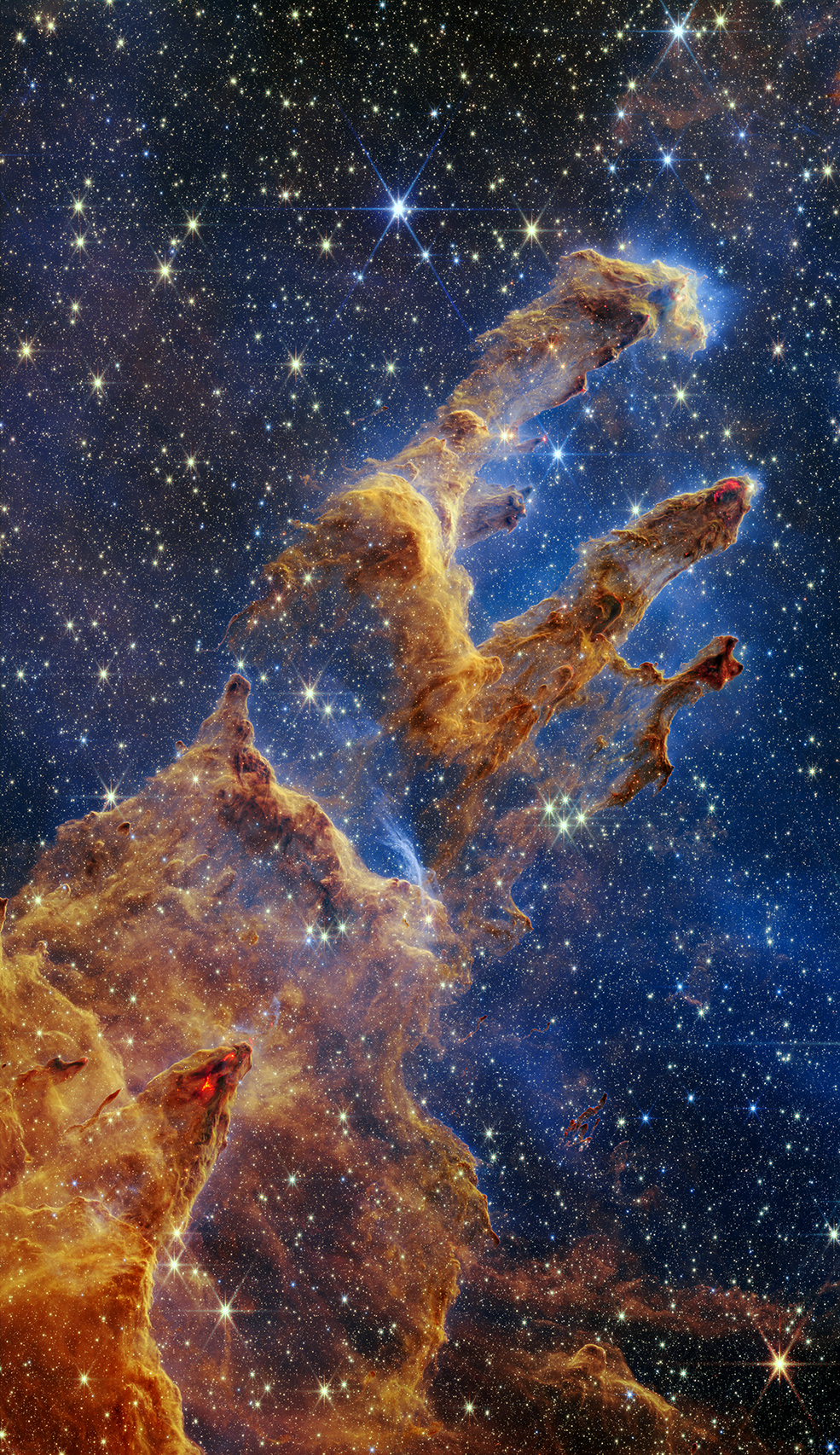
And this image of James Webb space telescope has remove this blockage and you can see many stars behind it. In fact, the red dots you are seeing in these pillars of Pillars of Creation are many new stars in this nebula which cannot be seen in visible light but can be seen easily in infrared.
Please take a little time and enjoy this picture of the James Webb space telescope. Now I want to highlight one or two more things in this picture.
One is that if you look at the close-up of the left pillar, you will see some fog. This is actually the same photoevaporation that I mentioned means these are the places that are evaporating due to the ultraviolet radiation of Big Stars.
Secondly, I will highlight number two and number three pillars of Pillars of Creation. You will see some reddish color features like a lava on them, this is actually not lava. The reason for this is that there are completely new stars inside these pillars. Then these new stars form many jets come out of them in the beginning. So what you are saying are red lava like feature is actually the interaction of the Jets of these new stars with the gas cloud. You don’t see those new stars. You are only indirectly finding that the hydrogen gas here is slightly excited because of them.
Why no background Galaxies?
No one last thing about this new James Webb space telescope image. Well I can talk about the same as for several weeks, but I have to give this articles a little short.
There’s an amazing thing about this image. Normally if you look at James Webb space telescope image you will see galaxies in the background. But in this picture there are just stars no distant galaxy in the background. That’s because we’re looking at the eagle nebula we’re actually looking inside our own Milky Way galaxy and lots of lots of stars!
Not only the stars but in a sense the gases and dust of our own Galaxy called the interstellar medium is so dense that we cannot see distant galaxies behind it. All these stars are either of the eagle nebula or our own galaxy, in a sense it is a veil that does not allow us to see the distant galaxies from here.
Conclusion
Okay leave this technical thing let’s again take a broad view.
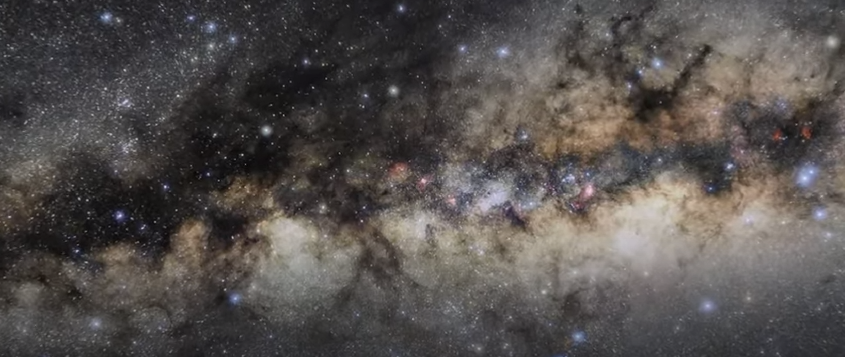
That distant image is of the eagle nebula, which is one such a region, where new stars are forming about 6000 light years away from us. This Hubble space telescope in the James Webb space telescope have given a very beautiful close-up of the central area which we have named “pillars of creation”. Our own sun and solar system was formed in a similar type of region about 4.5 billion years before.
Here in this pillar of creation many, many many many new solar system are forming. Who knows after several billion years, there may be such life present there who may be trying to find out how their Star was formed and maybe they would not be knowing even how beautiful was the nebula of which they were a part.
